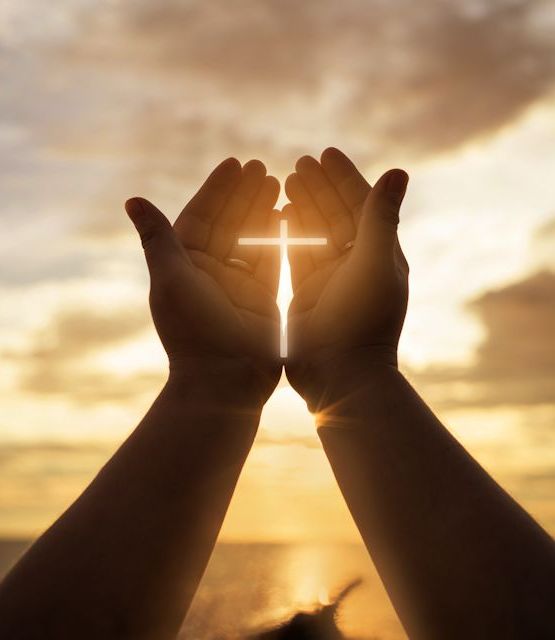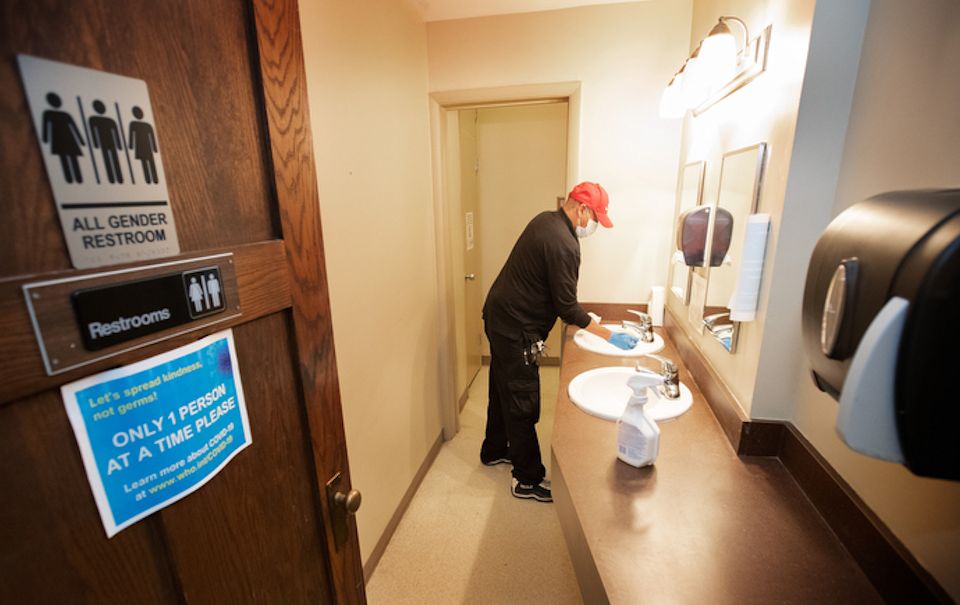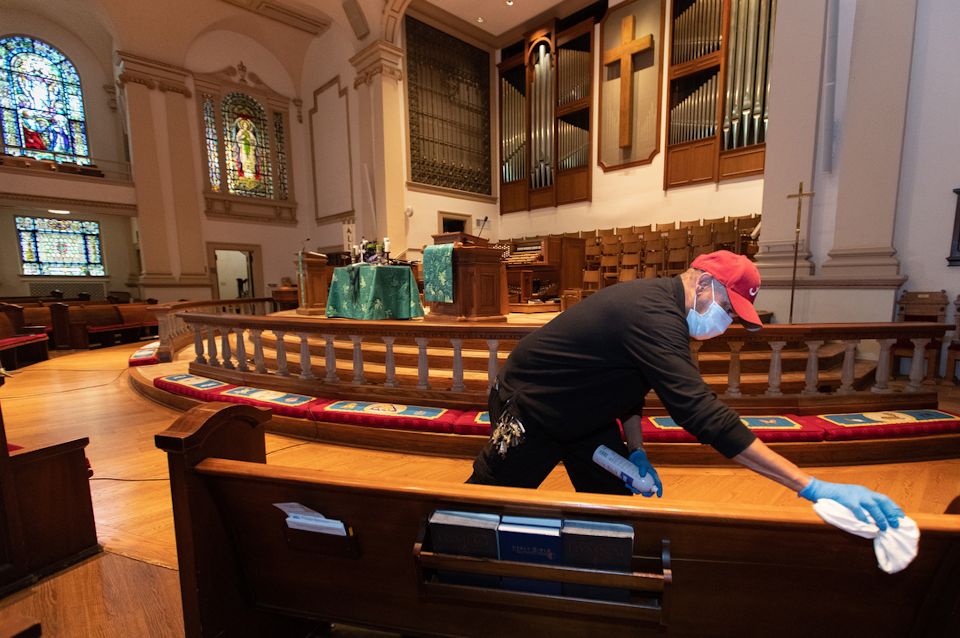Social distancing measures forced churches to transition to online worship and ministry. As states lift shelter-in-place orders, churches must consider how — or when— to return to in-person worship.
JOEY BUTLER
UM News

On May 10, 30 congregants and nine church staff met in the sanctuary at First United Methodist Church in Poplar Bluff, Missouri, for their first in-person worship since the coronavirus outbreak put a stop to such gatherings.
It was quite different from the 250 who typically worship at the church’s three Sunday services. Everyone sat three pews apart, and the normally large choir was reduced to a quartet, but the Rev. David Stewart, lead pastor, called it “an encouraging baby step.”
“One person told me, ‘I didn’t know how much I missed worshiping together until I did it again,’” he said.
The rise of the coronavirus pandemic and the social distancing measures that came with it forced churches to transition to online worship and ministry. Now, as many states lift shelter-in-place orders, churches must contemplate how — or whether — to return to in-person worship.
It’s not as simple as just staying six feet away. Corporate worship contains physical contact, from passing the peace to passing the collection plate, from the coffee machine to communion. Finding alternatives to certain acts and adhering to thorough cleaning and disinfecting measures will be a challenge.
Many conferences are utilizing a blog post by Lifeway’s Ken Braddy titled, “24 Questions Your Church Should Answer Before People Return.” The blog covers cleaning and maintaining distance, but also considerations about volunteers, greeters, special occasions like funerals and weddings, and accurately taking attendance.
The Rev. Allen Cason, the pastor of Metter United Methodist Church in Metter, Georgia, estimates it will be “five to 10 times as much work” for his church to hold in-person worship.
“We’d have to have multiple services and see if we have enough volunteers to do the necessary cleaning between each service. And whether we can acquire enough cleaning supplies at a reasonable price,” he said.
“Ultimately, does it still resemble worship once we put all these restrictions in place?”
The Rev. Susan Kent, the pastor of women’s ministry and worship at The Woodlands United Methodist Church in The Woodlands, Texas, also expressed concern about over-regulating the community experience of church.
“If there’s no coffee time, if we can’t open our cafe, if there’s no fellowship, then we’ve sterilized the gathering,” she said.
With two campuses and more than 14,000 members, The Woodlands church would be hard-pressed to add enough additional services to accommodate limits on the number of people currently allowed at a gathering. Kent said the church doesn’t favor that approach anyway and has no timetable for opening.
“I’ve seen churches looking at multiple services with a reservation system, but making reservations feels like ‘members-only’, and that’s not what we’re about,” she said. “We don’t want to rush opening the doors if it means we have to turn people away.”
Cason said he’s surveying church members asking what measures they’re willing to take in order to have in-person worship, including wearing masks and having their temperature taken, or feel comfortable leaving their children in the nursery.
Kelly Roberson, communications director for the South Georgia Conference, said in a May 5 conference webinar on reopening preparation that church leaders need to let everyone in the congregation know what’s happening.
“Tell them what steps you’ve taken and what’s expected of them as well. Explain what you are doing and why you’re not doing other things right now,” she said.
From the beginning of the pandemic, United Methodist bishops began issuing directives for churches in their episcopal areas to suspend in-person worship. Many extend past dates when their state governments are planning to relax quarantine measures.
Based on the orders of Michigan’s Governor, Gretchen Whitmer, Bishop David Bard requested that United Methodist local churches not hold in-person worship services until at least May 28, 2020. No announcement has been made as to when restrictions may be eased or lifted. However, Bard and conference leaders shared a publication on May 7 providing guidance on how to reopen safely, based on state and federal health recommendations. Bard addressed the Conference by video: “I miss the simple gifts of a handshake or hug, and I grieve that such gifts will have to wait even longer. We are giving up a lot, but self-giving is part of our identity as followers of Jesus … We stay home, not only for our own health but for the well-being of others.”
In the Greater Northwest Episcopal Area, where many states are reopening or loosening restrictions, Bishop Elaine JW Stanovsky has asked churches not to gather in person through May 30. She cited John Wesley’s principle to “do no harm” as her guidance.
“As Christians and citizens committed to protecting public health, we are responsible both to abide by the guidance of government and health officials, and to assess whether the church holds itself to a higher standard of caution than the states direct,” she wrote in her April 24 bishop’s letter.
Illinois Great Rivers Conference Bishop Frank J. Beard noted that though some counties in the state have loosened restrictions to allow “drive-in” worship, he is asking all United Methodists to observe the shelter-in-place set by Gov. J.B. Pritzker, which currently runs through May 29. The governor’s order is being challenged in court, but according to the conference newsletter, the bishop’s order will remain in effect even if restrictions are overturned.
On April 28, Bishops Robert T. Hoshibata, Desert Southwest Conference, and Minerva G. Carcaño, California-Nevada Conference, joined Nevada leaders of the Evangelical Lutheran Church in America in a letter urging Nevada Gov. Steve Sisolak to extend the state’s stay-at-home directive, which was set to expire April 30. Sisolak has extended the order through May 15.

In Eastern Pennsylvania, Bishop Peggy Johnson encouraged churches in her episcopal area to follow the guidance of their county health departments, as the state of Pennsylvania is operating on a phased reopening that began May 8.
Bethany United Methodist Church in Milton, Pennsylvania, is in a part of the state cleared for small gatherings, so it held its first in-person worship since March 15. Attendees had to maintain distance and wear gloves, and communion was offered in pre-packaged, individual, sealed cups.
“I hate to use the term ‘new normal.’ There is nothing normal about this,” the church’s pastor, the Rev. William McNeal, told The Daily Item newspaper.
Many bishops have an eye on May 24, Aldersgate Day, or May 31, Pentecost, as meaningful dates to resume in-person worship. However, others are looking to late June.
Once churches reopen, they will have to ponder what their post-coronavirus ministry will look like.
Many have found success in virtual worship and even have attracted “parishioners” from other parts of the country. They may be hesitant to cease a vibrant online ministry when in-person services resume.
“Even though it’s not what everyone wants, what we’re doing now is working,” Cason said, adding that giving at his church increased in March.
Johnson urged her congregations to keep it up. In a recent e-newsletter to the Eastern Pennsylvania Conference, she wrote, “Please continue to offer your wonderful online presence to the world that is your parish. We can never go back to the days of in-person, onsite worship only.”
Without additional support, scheduling both personal and virtual ministry could prove troubling to pastors who may have already been overworked and under-resourced before the pandemic.
West Ohio Conference Bishop Gregory Palmer said it might be necessary to prioritize and adapt ministry going forward.
In the conference e-newsletter, he wrote, “Make no mistake: We will be doing some old things in new ways, and we will not be doing some things at all.”
During an Arkansas Conference webinar on relaunching worship, the Rev. Todd Lovell, associate pastor of First United Methodist Church in Springdale, Arkansas, said the current situation is a good time for church leaders to evaluate what’s essential to their ministry.
“COVID-19 could allow churches to hit the reset button on our identity, to start ministries we’ve always wanted to and end others,” he said. “This is a good opportunity to rid ourselves of ‘legacy’ programs that the church has always done but may no longer support the mission.”
Lovell even uttered what could be considered blasphemy by many United Methodists: “We can still be a church if we don’t have potlucks.”
For now, Cason said he’s envisioning a first step back as the “Acts 2 house church model” where small groups will gather in each other’s homes to watch worship online and hold discussion afterward.
His bishop agrees.
On a May 4 Zoom meeting about the South Georgia Conference’s “rolling restart” plans, Bishop R. Lawson Bryan said, “Small groups will be the first step. This is what Methodists have been saying for 250 years: Christians grow best in small groups.”
Last Updated on November 13, 2023

